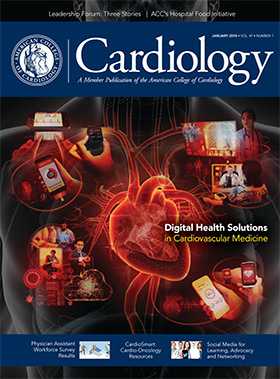Journal Wrap
The hottest research from various peer-reviewed journals - handpicked weekly by the ACC.org Editorial Board led by Kim Eagle, MD, MACC.
Newborn Screening Policies For CHD Associated With Lower Infant Deaths

Mandatory newborn screening policies for critical congenital heart disease (CHD) were associated with a significant reduction in infant deaths in states with these policies compared with those without, according to a study published in the Journal of the American Medical Association.
Rahi Abouk, PhD, et al., conducted an observational study to assess the number of early infant deaths (24 hours and six months of age) for critical CHD or other congenital cardiac causes, gathered by the National Center for Health Statistics’ linked birth and infant death data set for each state-month birth cohort from 2007 to 2013.
As of June 1, 2013, eight states had implemented mandatory CHD screening policies, five had voluntary screening policies and nine had adopted but not yet implemented mandatory policies. Read More >>>
Results showed that between 2007 and 2013, there were 2,734 deaths due to critical CHD and 3,967 deaths due to other or unspecified cardiac causes. Death rates due to critical CHD in states with mandatory screening policies were 8.0 per 100,000 births in 2007 and 6.4 per 100,000 births in 2013.
Additionally, results showed that state adoption of a mandatory newborn screening policy was associated with a significant decline of 33.4 percent in death rates due to critical CHD vs. states without the policy, with an absolute decline of 3.9 deaths per 100,000 births. The authors conclude that no significant decrease was found in critical CHD and infant deaths for states with nonvoluntary screening policies.
In an accompanying editorial comment, Alex R. Kemper, MD, MPH, MS, et al., note that “although important unanswered questions remain about the comparative effectiveness of different screening approaches, the evidence presented by Abouk and colleagues is reassuring that adopting a policy mandate for critical CHD newborn screening has saved lives.”
In encouraging news, 47 states and the District of Columbia now have mandatory screening policies in place. The College’s State Advocacy staff, working with ACC Chapters, have played a major role in both advocating for and implementing mandated critical CHD screening across the country.
Abouk R, Grosse SD, Ailes EC, et al. JAMA 2017;318:2111-18.
Study Finds Variation in Intensification vs. Deintensification of Guideline Recommendations
Current guidelines for diabetes and cardiovascular disease management provide more recommendations for intensification than deintensification of routine services, according to a research letter published in JAMA: Internal Medicine.
Adam A. Markovitz, BS, et al., examined guidelines for both diabetes and cardiovascular disease released by seven major guideline developers, from January 2012 through April 2016. The study included the services provided in the ambulatory setting, to the same patient over time, and under a primary care physician’s discretion. Read More >>>
Results showed that out of 361 recommendations, 256 (71 percent) were categorized as intensification and 105 (29 percent) were categorized as deintensification. The authors also found a large difference in how frequently guideline developers recommend deintensification, suggesting developers’ inconsistency with existing evidence on benefit and harm. Of recommendations backed by strong evidence, only 17 percent (17 of 99) addressed deintensification vs. 83 percent (82 of 99) that addressed intensification. Furthermore, the authors explain the reason for intensifying treatment is often due to more evidence regarding intensification. They add that performance measures rarely address overuse.
The authors conclude that “where clinical data are sparse, developers should demonstrate equal restraint in recommending intensification versus deintensification.” They add, “where evidence for harm is strong, developers should provide specific guidance in the form of clear recommendations, algorithms, and decision support tools on when, how, and for whom to stop or scale back care.”
Markovitz AA, Hofer TP, Froehlich W, et al. JAMA Intern Med 2017;Dec 18:[Epub ahead of print].
Paper Outlines Payment Reforms to Increase Collaboration Among Primary Care, Cardiology

A conceptual approach to payment reforms allowing for more effective collaboration between cardiology and primary care physicians in treating patients with chronic cardiovascular disease is at the center of a review published in JAMA Cardiology.
The review – a result of a collaboration between the Duke-Margolis Center for Health Policy and professional societies representing primary care and cardiology, including the ACC – outlines a proposed set of payment reforms, the core of which could qualify as an advanced alternative payment model under the Medicare Access and CHIP Reauthorization Act (MACRA). It also clearly defines the roles of participating physicians under each model where they share responsibility for patient care. Read More >>>
Specifically, the authors define two short-term payment models including a clinician-to-clinician consultation (CTCC) model and a multispecialty care coordination (MCC) model – both of which require effort from primary care physicians (PCPs) and cardiology clinicians. With MACRA and its resulting Quality Payment Program propelling the transition from a fee-for-service system to one focused on advanced Alternative Payment Models that address population health, the authors also propose a long-term third model focused on advanced chronic cardiovascular disease. This model, based on multispecialty professional fee capitation, would bundle professional fees for participating clinicians with an established longitudinal patient care relationship.
“To provide heart disease patients with the best possible care, it is essential that cardiologists and primary care clinicians work effectively together,” says Paul N. Casale, MD, MPH, FACC, ACC Board of Trustees member and a member of the U.S. Department of Health and Human Services Physician-Focused Payment Model Technical Advisory Committee. “This collaborative care framework and payment model offer an opportunity to link clinician roles and responsibilities to payment, thus improving value and the care experience for our patients.”
While the reforms focus on improving cardiovascular care, they could be adapted for a broad range of chronic health conditions that require primary-specialty care coordination. “Under this consensus proposal, patients would receive higher quality care that supports relationships with their physicians, providers would have improved pathways and support for their shared responsibility for a given patient’s health, and the health care system could benefit from better results and lower costs,” says Mark McClellan, MD, PhD, director of the Duke-Margolis Center for Health Policy and study co-author.
Farmer SA, Casale PN, Gillam LD, et al. JAMA Cardiol 2017;Nov 22:[Epub ahead of print].
Keywords: ACC Publications, Cardiology Magazine, Infant, Newborn, Infant, Fee-for-Service Plans, Physicians, Primary Care, Neonatal Screening, American Medical Association, Mandatory Testing, Advisory Committees, Consensus, National Center for Health Statistics, U.S., Trustees, Demography, Capitation Fee, Medicare, Primary Health Care, Sudden Infant Death, Referral and Consultation, Patient Care, Health Policy, Diabetes Mellitus, Heart Diseases, Cardiovascular Diseases, Algorithms, Cohort Studies
< Back to Listings

